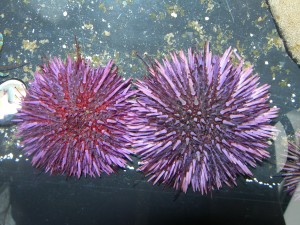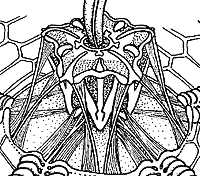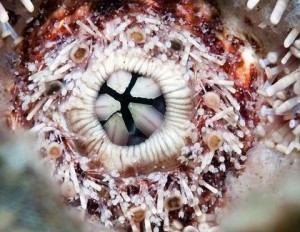Sea Urchins’ Teeth and Aristotle’s Lantern
 Did you know? The Purple Sea Urchin has protective large spines, pincers (called pedicellariae), tube feet and five teeth, arranged in a circle at the bottom of its body, that it uses to scrape algae from rock surfaces?
Did you know? The Purple Sea Urchin has protective large spines, pincers (called pedicellariae), tube feet and five teeth, arranged in a circle at the bottom of its body, that it uses to scrape algae from rock surfaces?
 Here’s what Aristotle had to say about this arrangement of teeth: “In reality the mouth-apparatus of the urchin is continuous from one end to the other, but to outward appearance it is not so, but looks like a horn lantern with the panes of horn left out.” Oh, yeah, in addition to philosophy, Aristotle wrote about Urchins in The History of Animals. In later years this lantern-like mouth came to be known as “Aristotle’s Lantern”. Possibly because of the drawing he included, which you can see here.
Here’s what Aristotle had to say about this arrangement of teeth: “In reality the mouth-apparatus of the urchin is continuous from one end to the other, but to outward appearance it is not so, but looks like a horn lantern with the panes of horn left out.” Oh, yeah, in addition to philosophy, Aristotle wrote about Urchins in The History of Animals. In later years this lantern-like mouth came to be known as “Aristotle’s Lantern”. Possibly because of the drawing he included, which you can see here.
 The urchin uses its Horn Lantern (if you’re Aristotle) or Aristotle’s Lantern (if you’re every other biologist in the world) to scrape away algae growing on rocks and create a depression that becomes the sea urchin’s hideaway. Sometimes a sea urchin grows larger than its dugout depression and gets stuck — for life. Once trapped, the urchin can only feed on particles that drift by with the current.
The urchin uses its Horn Lantern (if you’re Aristotle) or Aristotle’s Lantern (if you’re every other biologist in the world) to scrape away algae growing on rocks and create a depression that becomes the sea urchin’s hideaway. Sometimes a sea urchin grows larger than its dugout depression and gets stuck — for life. Once trapped, the urchin can only feed on particles that drift by with the current.
Whichever lantern you use to refer to an Urchin’s mouth, those teeth are pretty formidable. In areas without a lot of predators (like sea stars and sea otters), purple urchins are known for dramatically altering the kelp forest ecosystem and leaving behind a vast bare area, known as an urchin barren.
